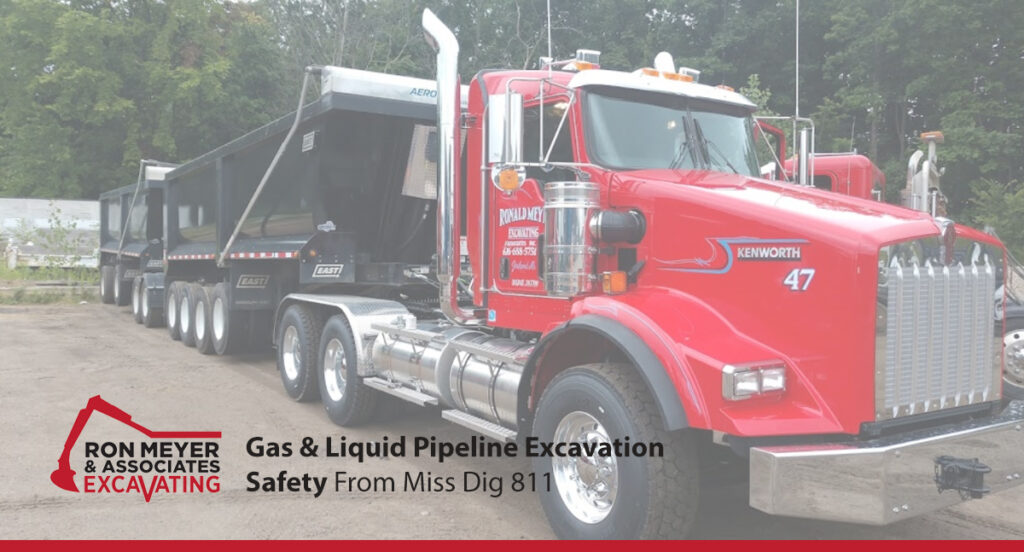
Each year thousands of utility strikes occur in Michigan, including damage to gas and pipeline facilities. These strikes cause service outages, put the public and employees at risk, and result in costly repair bills for excavators. The information provided within this booklet can help reduce or eliminate your likelihood of strikes occurring during your upcoming projects.
All pipeline companies, distribution and transmission, are required to use permanent markers to indicate the presence of gas lines in the area. Pipeline markers are yellow or white and red signs that identify the material being transported, an emergency number, and the name of the pipeline operator.
Important Reminder: Underground facility markers:
- Are not usually set directly over the pipeline.
- Do not specify the facility depth.
- Do not indicate a straight line between markers.Do
- not identify the number of pipelines or facilities in an area.
- Are found where pipelines and facilities cross a street, railroad, or waterway.
Facility Markers Always Include:
- The words Warning, Danger or Caution
- IMPORTANT: The federal code specifies that either “Gas (or the name of the gas transported) Pipeline” and “Petroleum (or the name of the hazardous liquid transported) Pipeline” must be on the line marker.
- An emergency phone number
- The name of the pipeline operator
Types of Pipelines
- Gathering lines collect oil and gas from areas of production. Are small pipelines, usually 2 to 8 inches in diameter, that move crude oil or gas mixtures from individual wellheads and production locations to processing facilities.
- Distribution pipelines deliver natural gas to people’s homes or businesses. Are used to move natural gas from the transmission system and storage facilities directly to residential and industrial consumers.
- Transmission pipelines transport material to and from storage, refining facilities, manufacturing centers, and places of distribution. Are large crosscountry pipelines, usually 20 to 42 inches in diameter, that are used to move product from production and processing facilities to distribution companies and large volume customers.
- Trunk Lines are larger pipelines, usually 8 to 24 inches in diameter, that bring crude oil from gathering centers, oil producing areas, pumping stations and ports.
If You Make Contact With A Pipeline
Stop your excavation and contact the facility company immediately, even if there is no apparent damage. Contacting the facility owner allows the gas or liquid pipeline company the opportunity to investigate and remediate if needed.
A pipeline that is pulled or bumped could break at a location away from the actual excavation site.
Evacuation
- DO leave the damaged area Upwind, Uphill or Upstream cautiously.
- DO call 911, if damages resulted in the escape of any gas or liquid.
- DO evacuate/ alert others near the scene.
- DO stay away from the scene.
- DO wait for an all clear signal to return to the area.
- DO contact the facility company.
- DO NOT touch any liquid or vapor that may have come from the pipeline.
- DO NOT initiate any open flame or other potential source of ignition such asan
- electrical switch or vehicle ignition or lighting a match.
- DO NOT smoke.
- DO NOT start motor vehicles or electrical equipment.
- DO NOT ring doorbells to notify others of the leak. Knock with your hand to avoid
- potential sparks from knockers.
- DO NOT drive into a leak or vapor cloud while leaving the area.
- DO NOT attempt to operate any pipeline valves yourself. You may inadvertently
- route more product to the leak or cause a secondary incident.
- DO NOT attempt to extinguish a petroleum product or natural gas fire. Wait
- for local firefighters and other professionals trained to deal with such
- emergencies. Burning gas will NOT explode.
- DO NOT cover the damaged pipe with dirt as a means of stopping the leak.
- DO NOT crimp plastic gas facilities.
- DO NOT attempt to plug damaged pipes
For more information, download the MISS DIG 811 Excavator Education Program (EEP) handbook for Gas and Liquid Pipeline.
At Ron Meyer & Associates Excavating, we’ve been providing underground and commercial construction to private and commercial businesses for 40+ years. As the general contractor or subcontractor, our experienced foremen, equipment operators, pipe layers, truck drivers and well-maintained equipment fleet make us an undeniable choice for your excavating services. Let’s talk about your project!

As 45 years of experience as an underground/site contactor and a third generation contractor, Ron takes time to go through each individual project with the supervisor and is responsible for all scheduling and equipment logistics. He’s also involved in all troubleshooting for projects.